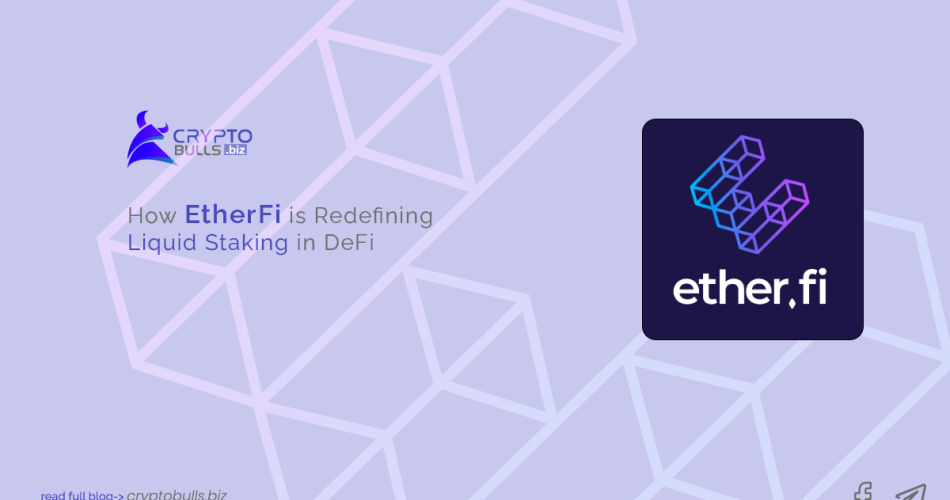eETH and Beyond: How EtherFi is Redefining Liquid Staking in DeFi
In the fast evolving world of decentralized finance (DeFi), there is a compelling demand for a non-custodial liquid stacking solution. The risk of centralization is a significant concern in the world of decentralized finance (DeFi) as it contradicts the fundamental principle of decentralization that upholds blockchain technology. Existing Liquid Staking Decentralized (LSD) protocols, such as Lido, face this challenge due to a limited number of validators. Governance risks and potential regulatory censorship also pose another substantial challenge to DeFi protocols. If a protocol stakes a majority of the Ether in circulation, it could face censorship demands and other power abuses. These are precisely the kind of issues that blockchain technology was designed to avoid. This concern underscores the necessity for an innovative solution like EtherFi. By adopting a ground-breaking Non-Custodial Staking protocol, EtherFi plans to overcome the centralization issues that have emerged within the DeFi ecosystem. Every shareholder is empowered by this innovative strategy, which guarantees everyone a voice and distributes power evenly across all tokens. The introduction of EtherFi as a ground-breaking liquid staking protocol holds the potential to reinvent staking, liquidity, and decentralization while addressing a major issue that has clouded the DeFi environment.
What is EtherFi?
EtherFi is a non-custodial liquid staking protocol that allows users to stake their ether ETH while maintaining control over their keys. This is in contrast to other liquid staking protocols, which require users to deposit their ether (ETH) into a smart contract and give up their custody of their assets. EtherFi works by minting Non-Fungible Tokens NFTs for each validator launched via the protocol, which then is used to create a liquidity pool, from which the liquid staking derivative token eETH is minted. eETH holders receive a share of the staking rewards generated by the pool’s validators.
What makes EtherFi Different?
EtherFi offers several unique features over traditional staking protocols that set it apart from other staking protocols; these features are:
Non-Custodial Staking
Here, the user always maintains control of their keys, unlike most other delegated staking protocols. EtherFi also allows stakers to generate and hold their own staked ETH keys. This helps users retain the custody of their ETH while delegating staking to a node operator and significantly reducing their risk.
NFTs for Validators
NFT is minted for every validator launched via EtherFi. These NFTs control the 32 ETH staked and store the metadata related to the validator (i.e., the client it runs, its geography, the node operator, and any node service running on it). This creates a new programmable layer on top of the staking infrastructure.
Node Services Marketplace
EtherFi also allows the creation of a node service marketplace where stakeholders and node operators can enroll nodes to provide infrastructure services. The revenue generated from these services is then shared with the stakeholders and the node operators.
Liquid Staking Derivative Tokens (eETH)
The Liquid Staking Derivative token (eETH) is minted from a liquidity pool containing the NFTs minted for the validators launched on EtherFi.
How EtherFi Operates
The EtherFi project has a roadmap which is aimed at making liquid staking more efficient, accessible, and secure. It is also aimed at providing node operators with the tools and resources they need to succeed. There are 3 phases on the ether.fi roadmap:
Phase 1: Delegate staking (Deleg8)
This phase is focused on making liquid staking more efficient and accessible. Here, users’ stakeholders can stake their ETH on the EtherFi platform, receive staking rewards, and be free to withdraw their Ether (ETH) and rewards anytime. EtherFi also uses NFTs to represent staked ETH, which makes the process more efficient.
To deposit ETH into the EtherFi protocol, users must first create an account and connect their wallet. Once they have connected their wallet, they can select the amount of ETH they want to deposit and confirm the transaction.
Here is the step-by-step workflow of Phase 1:
- Node operators submit bids to be assigned a validator node to run.
- Stakers deposit 32 ETH into the EtherFi deposit contract.
- The auction mechanism assigns a node operator to run the validator and mints a withdrawal safe and two NFTs (T-NFT and B-NFT).
- The stalker encrypts the validator key using the public key of the winning node operator and submits it as an on-chain transaction.
- The node operator launches the validator using the decrypted validator key.
- The staker (or node operator) may submit the exit command to exit the validator and recover the staked ETH into the withdrawal safe. The stalker can then burn the NFTs to recover their ETH net of fees.
Phase 2: Liquidity Pool and eETH (Pool Fiesta)
This is the phase where the main focus is to improve the liquidity of the pool of the EtherFi ecosystem. EtherFi will integrate an oracle to get information about validator nodes and launch its liquidity-staking derivative token (eETH). EtherFi will launch a liquidity pool where users can trade ETH, eETH, and T-NFTs. In the final step, EtherFi will launch a treasury management contract to manage its protocol funds.
Once a user has deposited ETH, EtherFi will mint an NFT for each validator launched via the protocol. These NFTs represent the user’s stake in the EtherFi protocol. The NFTs are then used to create a liquidity pool for the liquid staking derivative token eETH. This liquidity pool allows users to trade eETH for ETH and vice versa.
Here is the step-by-step workflow of Phase 2:
- Stakers with less than 32 ETH or those who don’t want to manage validator nodes can participate in EtherFi staking by creating eETH in an NFT liquidity pool.
- The liquidity pool holds a mix of ETH and T-NFTs (Tokens as NFTs).
- To make eETH, you deposit ETH into the pool, and the pool gives you eETH tokens in return.
- If you have T-NFTs, you can put them in the pool to get eETH based on their value.
- eETH holders can swap it for ETH in the pool at a 1:1 rate, but if there’s not enough ETH, it can trigger a validator exit.
- Some stakers want to stake with B-NFTs for higher returns. They deposit ETH and join a queue to get a B-NFT.
- When the pool’s ETH balance reaches a certain level, the next staker in the B-NFT queue gets assigned. They initiate staking, create two NFTs (T-NFT and B-NFT), and stake 32 ETH.
- If the ETH balance drops below a threshold, the oldest T-NFT triggers an exit request. The corresponding B-NFT holder is alerted.
- The exit request sets a timer, and if the validator isn’t exited in time, the B-NFT holder faces penalties. The node operator gets a reward for a timely exit.
- When a validator exits, both the T-NFT and B-NFT are burned, and the remaining ETH (minus fees) goes back into the liquidity pool.
Phase 3: Node Services (Boost)
The main focus of this phase is to improve the security and decentralization of the etherFi protocol and provide node operators with the tools and resources they need. EtherFi will release its node client and integrate Distributed Validator Technology (DVT) to improve the security and decentralization of its protocol. EtherFi will also launch an infrastructure service for node operators and a billing contract for its infrastructure services.
Once the liquidity pool has been created, EtherFi will mint eETH and distribute it to users in proportion to their ETH deposits. eETH holders receive a share of the staking rewards generated by the validators in the pool. eETH holders can redeem their eETH for ETH at any time. To do this, they must deposit their eETH into the liquidity pool and swap it for ETH.
Here is the step-by-step workflow of Phase 3:
- NFTs can be enrolled to provide node services by setting metadata parameters that are part of the NFT contract.
- In the initial implementation, the node operator must run the EtherFi client bundle and be registered to provide node services.
- All three parties must effectively consent to enroll any given node to provide additional services — the node operator, B-NFT holder, and EtherFi.
- The node client bundle is an easy-to-use CLI that allows launching, monitoring, and registering clients on EtherFi.
- Billing for node services is executed via a billing contract. Services tracking and attribution are done via a centralized service run by EtherFi. This will change over time.
Impact of EtherFi
EtherFi has the potential to make a significant impact on the Ethereum Ecosystem by making staking more accessible, secure, and liquid. EtherFi could also help improve the decentralization of the Ethereum network by making it easier for smaller stakers to participate, reducing the risk of centralization and making the network more secure.
EtherFi’s innovative approach has several potential benefits, including:
- Enhanced security as the user maintains control over their keys, eventually reducing the risk of loss due to hacking or mismanagement
- Increased Liquidity as the eETH token provides users a liquid way of participating in staking without locking up their Ether (ETH) for an extended period.
- They are making it easier for users to participate in staking by reducing the barriers to entering staking regardless of their technical expertise or financial resources.
- Being a decentralized protocol helps EtherFi improve its overall security and resilience of the Ethereum ecosystem.
Future of EtherFi
EtherFi’s recent fundraising of $5.3 million and the launch of its liquid staking token, eETH, are positive signs of the future of the EtherFi project. This fundraiser was co-led by North Island Ventures, Chapter One, and Node Capital and also included participation from BitMex founder Arthur Hayes. The successful fundraiser shows investors’ strong confidence in EtherFi’s potential and provides the capital for the platform to pursue further partnerships, expand its operations, and help accelerate its development and adoption of the protocol. The funds will be used to hire more engineers for the team to strengthen EtherFi’s technical capabilities. EtherFi is also pursuing some node operators, such as Kiln and Finoa, for further partnerships. These partnerships will play a crucial role for EtherFi in expanding its network and enhancing its services.
EtherFi has also rolled out its liquid staking token, eETH. This token can automatically be restated on EigenLayer, a distributed validator technology protocol that promises to improve the security and scalability of staking. Eigenlayer is one of the most popular staking protocols, with more than $210 million in total value locked (TVL). This integration will not only provide additional liquidity but also enhance the yield for eETH holders. The launch of eETH is a milestone achievement for EtherFi as it introduces a new way to secure cryptocurrencies. It allows users to earn higher Annual percentage yields (APYs) without limits, making it an attractive option for users who want to maximize their staking returns.


